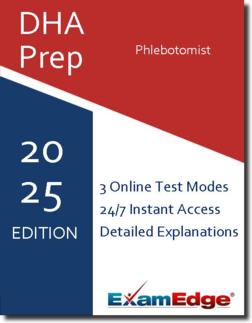DHA Phlebotomist (DHA-Phleb) Practice Tests & Test Prep - Topics
Based on 17 Reviews
- Real Exam Simulation: Timed questions and matching content build comfort for your DHA Phlebotomist test day.
- Instant, 24/7 Access: Web-based DHA Phlebotomist practice exams with no software needed.
- Clear Explanations: Step-by-step answers and explanations for your DHA exam to strengthen understanding.
- Boosted Confidence: Reduces anxiety and improves test-taking skills to ace your DHA Phlebotomist (DHA-Phleb).

Understanding the exact breakdown of the DHA Phlebotomist test will help you know what to expect and how to most effectively prepare. The DHA Phlebotomist has 70 multiple-choice questions The exam will be broken down into the sections below:
| DHA Phlebotomist Exam Blueprint | ||
|---|---|---|
| Domain Name | % | Number of Questions |
| Obtaining Blood Samples | 41.5% | 29 |
| Specimen Collection and Processing | 15.5% | 11 |
| Time Management and Assignment Organization | 8% | 6 |
| Professional Communications | 5.5% | 4 |
| Clerical Skills and Duties | 4.5% | 3 |
| Safety Standards and Procedures | 10% | 7 |
| Legal, Ethical, and Professional Considerations | 6% | 4 |
| Terminology, Anatomy, and Physiology | 9% | 6 |


